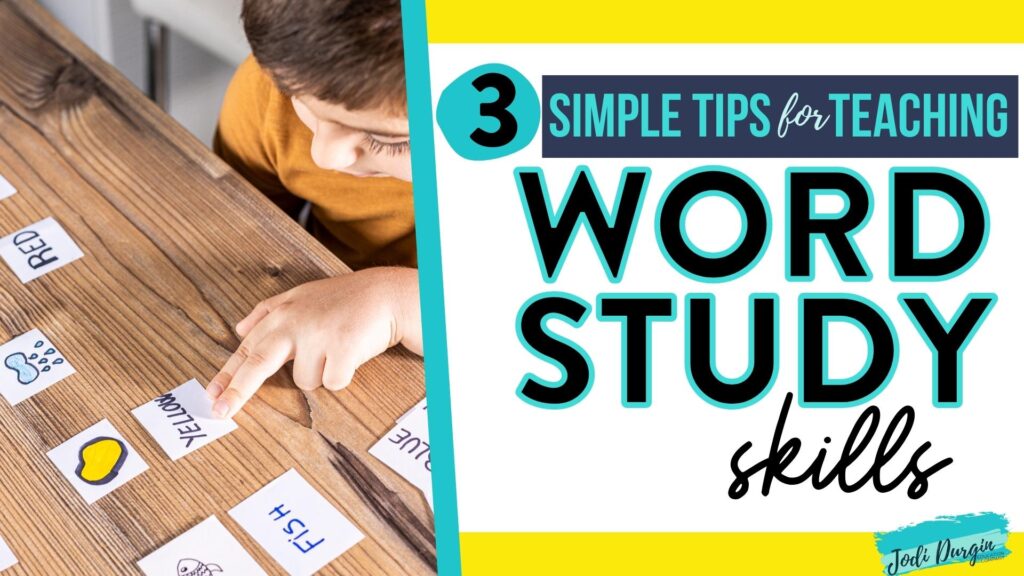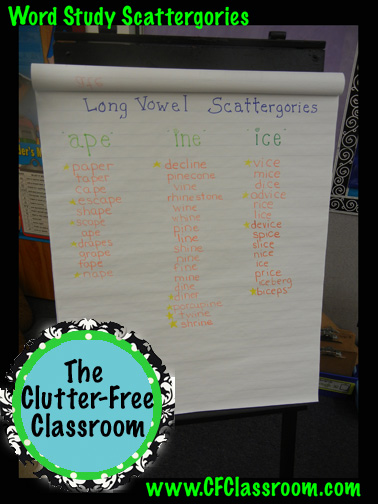Before I get into sharing some simple word study ideas, let me tell you something: sometimes things are just ironic. I’ve been working with my first grade son on word study patterns that complement his weekly focus in class. For example, last week they did long i using “magic e” so I created some games for him to expose him to all of the ways to make the long i sound. He’s loving it and I’m loving that he’s sorting and reading the patterns. The irony comes from the fact that I have randomly been receiving a notable number of emails asking me about word study and what I do and use. Read below to get some helpful word study ideas for elementary teachers you can use in your classroom.
3 Word Study Ideas for Elementary Teachers
Below are 3 word study ideas for elementary teachers.
1. Use Anchor Charts
The first word study idea on the list is to use anchor charts. Anchor charts are a great tool for teaching word study. They are creating for modeling and serving as a reference tool as students work independently or with partners. Let me share an example of how I use them in my classroom!
Below you can see an anchor chart I used to model how to play the game scattergories.
This activity was perfect when we were also studying data and graphing in math. Ultimately, my students will need to sort data into categories, pose a question, and create a visual to represent their findings. It’s a lot for their little 8-year-old brains to grasp. I always find the “forming categories” to be the most challenging part. We had a breakthrough moment today when I related the concept to sections of the grocery store (produce, canned goods, meats, freezer). Wish I thought of that one sooner!
Anyway, we played Scattergories as a fun word study activity. It was so much fun! The goal was to include words that nobody else had listed. After the time period ended, I manned the chart paper and began taking words from volunteers. A child would say a word. I would write it on the chart and ask, “Does anyone else have that word on their list?”.
If other students had also written the word down on the chart paper, they would give the silent “me too” signal in response. This is a great classroom management strategy!
If the word is on more than one student’s paper, then they would draw a line through it. If a child was the only one to think of the word he would circle it and I added a star on the chart next to the word.
I was so impressed with the words they came up with and we had a great time building our lists!
I recommend you try this word study idea in your classroom!
2. Incorporate Fun Hands On Learning and Games
The second word study idea on the list is to incorporate fun hands on learning experiences.
As elementary teachers, we know how important it is to incorporate hands on learning opportunities and fun games in our classroom. It engages students in their learning and results in better learning outcomes. Of course we should incorporate it into our word study instruction as well.
I’m really focusing on word study as opposed to just “spelling” this year and have been designing some games and activities to go with it. I wanted to come up with some materials that could be used week after week by simply changing out the word patterns. My hope was that they would become familiar with the directions which would make the activities more efficient and beneficial to them.
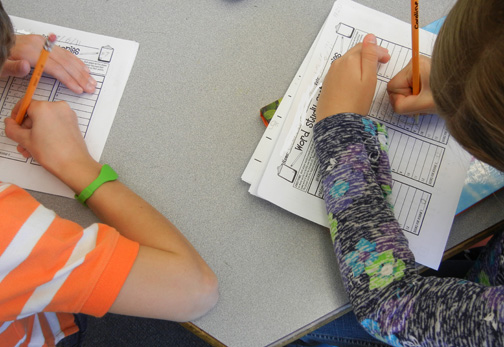
A word study center that is open-ended, highly engaging, student-driven, reusable, and easily prepped… Does this exist and where can I find it?! Good news: it does! You can find it right here. It is an interactive word study display called BOGGLE. It’s one of my favorite word study games!
This word study activity invites students to explore letters to create words. It is based on the game BOGGLE, which you may have played when you were younger. It serves as a great whole group game, small group activity, and reusable center.
Are you looking for a word study center that is engaging, reusable, and open-ended for differentiation purposes? This BOGGLE center is exactly what you need! Learn all about my Boggle Word Study Game resource! It’s one of my favorite word study ideas for elementary teachers.
Scoop up this Boggle Word Study Game Board!
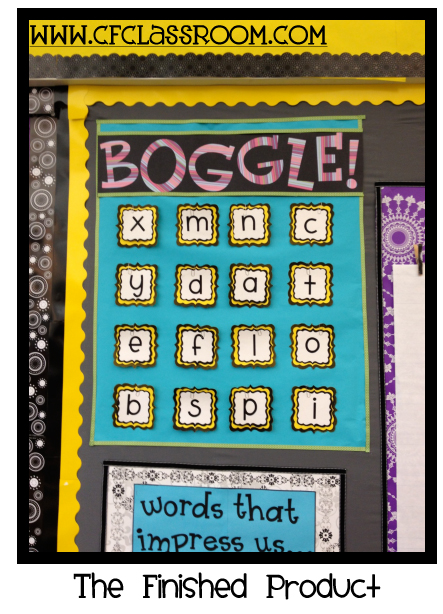
3. Offer Daily Practice
This word study idea may seem obvious, but it’s important to note. Students need to be working on word study skills regularly. One way to offer daily practice is by incorporating a word study center in your literacy centers.
We have a list of spelling words that accompany our reading curriculum (Treasures). I use that as a guide, but differentiate my lists to meet the needs of my learners. This meant I needed to create activities that were open-ended in the sense that the students could be doing the same activity, but with their own personal word lists.
I use these printable spelling activities with spelling lists, word study lists, vocabulary, and content area words. I also use them as homework pages. They are also great to leave when you have a sub. Oh, and if you are a Daily 5er, then these rock for Word Work.
Download these printable spelling activities now!
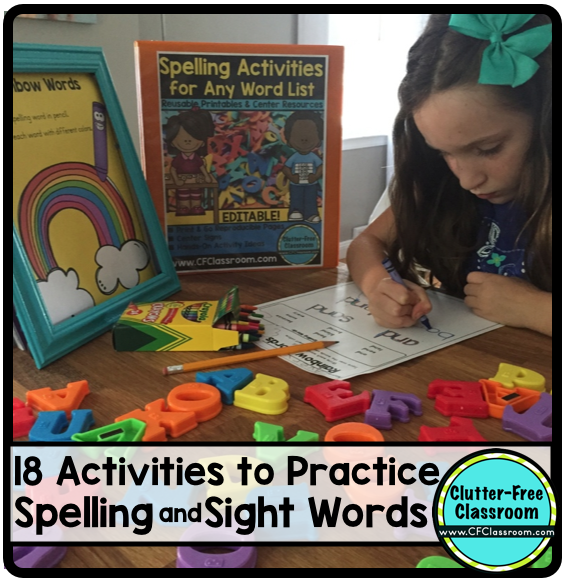
In closing, I hope you found these word study ideas for elementary teachers helpful! If you did, then you may also be interested in these posts and resources:
- The Best Back to School Read Alouds for Elementary Teachers
- How to Read a Picture Book Every Day to Your 1st-3rd Grade Students
- Must-Have First Day of School Picture Books for Elementary Teachers
- How to Use Spelling Activities in Your Elementary Classroom
- How to Use Printable Boggle Board for Elementary Teachers
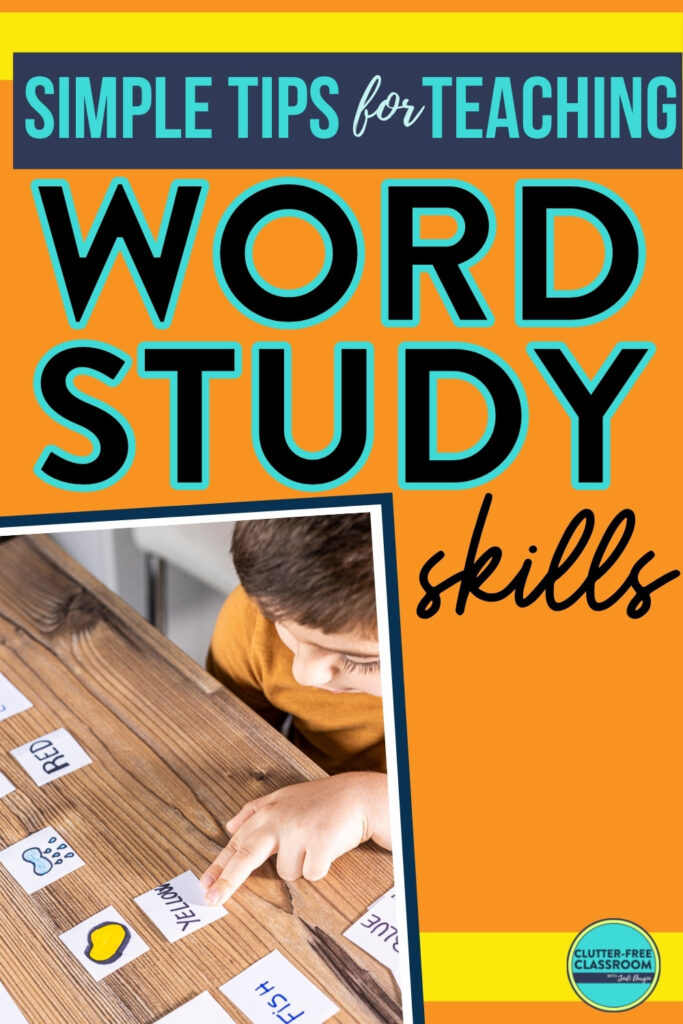
© 2023 Prezi Inc.
Terms & Privacy Policy
If your school is working on implementing teaching practices that align with the science of reading, then chances are you are probably going to be giving a lot more instructional time to word study.
If you are a third, fourth, or fifth-grade teacher, then you have probably been told that you need to make word study a priority this year, but maybe you’re wondering what exactly word study is.
Simply put, word study is the study of words.
It is the part of our instructional day that teaches students how words work.
Word study is the process of learning everything about words: spelling, meaning, pronunciation, historical origin, and connection to other words.
When you think of word study instruction in upper elementary, you want to keep a big picture perspective. We want to make sure that we are giving students tools that will make them skilled readers.
Word study lessons can help our students make progress towards that goal.
Why is word study important in upper elementary?
- If we want our students to be skilled readers, they have to have a foundation that allows them to actually read and understand the words they see on a page, and your word study instruction will help with that.
- In upper elementary, students start to see more multisyllabic words. Many students who are fluent or proficient readers in the primary grades start to struggle when they see big words. It’s possible they were fine reading single syllable words, and they might have a strong phonics foundation, but with the introduction of multisyllabic words, they start to struggle. Word study instruction can help students read multisyllabic words.
- Word study lessons also support both reading and writing.
- Finally, it is estimated that over 60% of English words have meanings that can be predicted from their word parts. This means we definitely want to be giving enough focus on word study to give students the tools to help them understand the meaning of most words they encounter.
What does effective word study instruction look like in upper elementary?
There are three steps you can take to create an effective word study block in upper elementary.
- You need to provide systematic and explicit instruction.
- You need to provide students with opportunities to play with, manipulate, and explore words.
- You need to provide opportunities for students to transfer their word study understanding to the texts they read.
Let’s break each step down.

Step 1: Provide Explicit and Systematic Instruction:
When we are teaching word study concepts, we want our instruction to be both explicit and systematic.
Systematic refers to the order in which you teach the concepts.
You want to teach your words study lessons in an order that makes sense. You want to start with simple concepts and progress to more complex or challenging ones.
For example. If you are teaching your students about word parts and how each part of a word has a meaning that can help readers figure out the meaning of the whole word, then you might follow a progression like this:
- Start by introducing compound words.
- Move into prefixes.
- Introduce suffixes
- Explain that some suffixes are inflectional, and some are derivational.
- Show students examples of words that have both prefixes and suffixes.
- Then you might introduce common Latin roots.
- Then you probably move on to explain Greek roots and combining forms.
So rather than just jumping straight into your instruction about roots (which is a key standard in upper elementary), you start by teaching the more simple and basic concepts and build on the knowledge your students have as you progress to the more advanced concepts.
Explicit instruction refers to how you teach your lessons.
Whether you are teaching whole group or small group, you can provide explicit instruction. Explicit instruction means you are being specific and intentional with how you explain and model word study concepts.
- You want to introduce word study concepts one at a time (small bite-sized chunks).
- Define terms and use academic language.
- Model using concrete examples.
- Show students examples of words that are the exception to the rule.
For example, if you are teaching suffixes to your students, you wouldn’t just explain that adding a suffix can change the meaning of the word, but you would explain that suffixes can change the spelling, meaning, pronunciation, and even the part of speech.
When we introduce and teach a word study concept, we want our students to have a full understanding of that specific topic.

Step 2: Give Students Opportunities to Explore and Play With Words
Before students can fully master and apply their word study knowledge to their independent reading and writing, they need an opportunity to play with words in a hands-on way.
This is often the missing link in word study instruction. We don’t always give our students an opportunity to play with words but instead expect that after one whole group lesson, they have mastered the concept.
When students get to play with and explore words, not only do they develop a much deeper understanding of the concept, but they start to feel much more confident in their ability to notice word study generalizations. They also get a chance to apply what they are learning in a fun and engaging way.
One of my favorite activities for wordplay is word of the week.
Word of the week is a super simple word study routine that can be modified or adapted to address a variety of word study concepts like context clues, prefixes, suffixes, and roots.
Here are some other ideas for activities that you could incorporate into your word study lessons:
- Word Ladders
- Word Sorts
- Building Words
- Word Webs
Word play activities word great in literacy work stations or are part of any independent practice routine.

Step 3: Help students transfer their word study understanding to the texts they read.
The ultimate goal of our word study instruction is to help students become more fluent readers (automatically reading a text with comprehension) and strong writers. So we don’t want their word study knowledge to only be present during word study lessons.
This means we need to actively provide opportunities and reminders to help students transfer what you have taught them during word study lessons to their actual reading and writing.
Once you have explicitly taught a concept, you want to regularly review, discuss, and spiral it into your literacy instruction to support automaticity and fluency.
This can be done with any and all teaching experiences.
Anytime you are encountering words, take a minute to find a word that includes a word study concept and point it out to your students. Do a short little mini-lesson on that word and show students how the word study lessons you’ve been teaching are helping them read, spell, pronounce, or understand the words they read.
Consider bringing word study into the following parts of your instructional day:
- Read Alouds
- Other Content Areas
- Small Group Lessons
- Morning meetings
- Literacy Workstations
Basically, anytime you are reading or writing something, you have the opportunity to reinforce word study concepts.
One of the really cool things about word study is that your word study instruction doesn’t have to be long.
Your explicit and introduction lessons might take 5-10 minutes, but once you’ve introduced a word study concept, you’re giving your students permission to notice that word study concept in anything they are reading and writing.
Put it into practice…
If you are ready to take action and start to give more focus to your word study lessons, here are three things you can do.
- Grab my Word of the Week freebie and introduce that routine to your students.
- Listen to episode #94 of the podcast, where I share four word study concepts every upper elementary teacher should be teaching.
- Come join us inside The Stellar Teacher Reading Membership to get access to a ton of word study resources and support so you know how to incorporate them into your classroom.
Happy Teaching!
A few years ago, I wrote a blog post about how I used a variation of Daily Three in my reading classroom. Since writing that post, I have gotten several questions about a word study activity I mentioned in the post.
As an upper grades teacher, I have always struggled with finding word study activities that are appropriate for my students. To be honest, I still struggle and my personal goal for this school year is to work on developing or finding more word study activities that are engaging, grade level appropriate, and truly help my students think about, analyze, and explore words. This post shares one of my favorite go-to word study activities for upper elementary students that I have used for the past five years. This word study activity can be completed during centers or even as a whole group activity.
About the Word Study Activity
Basically, students choose one of their spelling words for the week and then “Make Connections” between that word and other known words or words they specifically search for while they are reading.
Here are the “Making Connections” choices that students can choose from at the beginning of the year to complete this word study activity. We do add to this list as the year goes on and the students become more proficient with these choices and are ready for more.
Introducing the Word Study Activity
I spend the first few weeks of school modeling each one of the choices. It helps ensure the students understand the choice and understand how to find words that meet that requirement.
To do model this, we choose one word from our spelling list. The students help me choose “Making Connections” choices from the list that we have not used before. We go through the entire activity with students volunteering words that fit the choices we chose. When we have four words for each, I have them choose another word from the list to complete the activity on their own with the same “Making Connections” choices.
This can be done on a piece of paper easily, but I like to use a printable. It helps keep the work neat and organized, and I really dislike grading things work like this on notebook paper for some reason.
The students write their chosen word in the middle of the printable. Then they write their four chosen “Making Connections” choices in the four outer boxes. As you can see, this student chose same number of syllables, synonyms, same part of speech, and same ending sound.
Completing the Word Study Activity
After making their choices and clearly labeling each box with their choice, students get to work finding words that they can connect with their chosen spelling words. They can pull from their own knowledge, previous spelling lists, books they are reading, and even dictionaries.
I do require that they double check the spelling in a dictionary before recording the word in their printable. This takes extra time at first, but it takes care of my dictionary skills for the year and the students get faster as they use it more.
I also have a requirement of at least four words in each of the outer boxes. However, I have been known to allow students to do five in one box and three as long as they average about four words in each box.
Since this word study activity requires thinking, searching, and double-checking with dictionaries, I only require one printable (with one spelling word) to be completed during a 20 minute center in the beginning of the year. After Christmas, I require two to be completed. I do have some students who actually finish more than the required amount during the time frame. For students who need more time, you could lower the requirement to two words per “connection.”
In addition to using this in a word work center or station, this can also be done whole group. Read more about implementing word study in a whole class format versus centers by clicking here.
Download the Word Study Activity Printable Here
Click here or on the image below to download the FREE word study activity printable.
Do you have any word study activities that you have your students complete that you love? Let me know in the comments.
Want more word work activities? Click here to check out my FREE Word Work Activities using Jenga blocks!
Presentation on theme: «An Introduction to Word Study In the Elementary Grades»— Presentation transcript:
1
An Introduction to Word Study In the Elementary Grades
Susan Burgio Allendale Elementary
2
Sorting is the heart of word study!
3
Benefits of word sorting approach
Students make their own discoveries and form their own generalizations about how English spelling works Requires students to pay attention to words and make logical decisions about sound, pattern, and/or meaning Sorting is analytic- students work from known words and examine their parts Sorting does not rely on rote memorization or recitation of rules Easy to differentiate instruction among groups of learners
4
Sorting and Extension activities
Sorts Extensions and Follow-Up Routines Teacher-Directed Closed Sort Repeated Sorts Teacher-Directed Guess My Category Sort Buddy Sorts Blind Sorts Student-Centered Open Sort Writing Sorts Blind Writing Sorts Word Hunts Speed Sorts Draw and Label/ Cut and Paste Games
5
Types of Sorts Closed Sort: Students sort words with given categories or guided words provided by the teacher (categories and/or guide words are in bold print). Students are encourage to say each word as they put them into the correct category so that they can hear the pattern being taught. Open Sort: Students create their own categories for a set of words different than the categories set in the closed sort. Students are to find ways to group the words according to vowel patterns, meanings, parts of speech ,etc. Blind Sort: Using given guide words, students spell or write words in the correct category as a partner calls each word aloud without showing it. For younger grades, students may point to the correct category after hearing the word called out. Writing Sort: Students write their words under the correct categories Speed Sort: Students sort words quickly under the correct categories (use a timer to see how fast they can do it!) Students love to beat records and set goals for themselves. Word Hunt: Students hunt through their own reading and writing for words that are additional examples of the sound, pattern or meaning unit they studying.
6
Teacher talk and student reflection
Critical part of word study instruction is the discussion! Questions to generate talk about words: What do you notice about these words? How are they alike? Where in the word do you find the spelling pattern? In your word hunts, which pattern did you find more frequently? Can you divide the word into parts? What is the base word? Are there any prefixes or suffixes? Can you think of other words that sound or look the same? What did you learn that might help you become a better speller or a better reader?
7
Managing word study in the classroom
Develop a familiar weekly routine with daily activities Schedule time for group work with the teacher Keep it short Plan time for students to sort independently and with partners
8
Scheduling time for word study
Word study as an extension of the reading group Separate word study groups in a circle-seat- center rotation Word study block Individualized word study in intervention settings
9
Sample weekly schedule for students working with picture sorts
Monday: Picture sort Tuesday: Draw and Label Wednesday: Cut and Paste Thursday: Word and Picture Hunts Friday: Game Day and Assessment
10
Sample Weekly schedule for elementary students
Monday: Introduce the Sort (cut and discuss) Tuesday: Practice the Sort, Initial Speed Sort, and Writing Sort Wednesday: Blind Sorts and Writing Sorts Thursday: Second Speed Sort and Word Hunts using short text or independent reading books Friday: Games and/or Assessments
11
Word study assessments – STUDENTS MUST BE HELD ACCOUNTABLE FOR LEARNING
“Spelling test as writing sort 1 point for word in correct column 1 point for word spelled correctly Students should be expected to score 90% or higher on these assessments if they are placed in the correct groups and engaged in a variety of activities throughout the week. “Traditional” spelling test format can be used
12
Spelling expectations
Invented Spelling? Set reasonable expectations for accuracy in spelling and subsequent writing Even though invented spelling is encouraged, ALWAYS hold students accountable for what they have been taught If they’ve been taught consonant-to-letter correspondences, they should be able to spell those sounds correctly as in: PGS LK MD (Pigs like mud.)
13
Ten principles of word study instruction: Look for what students use but confuse
Instruct in students’ “Zone of Proximal Development”– in areas they already know something about – Give a SPELLING INVENTORY at the beginning of the year to start out. The Reading and Writing Project have the primary and elementary lists on line – which are the Words Their Way lists. The Spelling Inventory lists can be found on my teacher webpage under the “Just for Teachers” tab on the left. (K-1) By analyzing invented spellings, a ZPD is established and instruction can be planned that addresses those features students are using but confusing, not those they totally neglect
14
Ten principles of word study instruction: a step backward is a step forward
Always try to contrast something new with something already known (utilize background knowledge) It is important to begin word study activities where students will experience success
15
Ten principles of word study instruction: use words students can read
Because learning to spell involves achieving a match between the spoken language and the written language, students should analyze words they can readily pronounce It is easier to look across words for patterns or similarities when the words are easy for students to pronounce
16
What something is is also defined by what it is not
Ten principles of word study instruction: compare words that “do” with words that “don’t” What something is is also defined by what it is not Contrasts are essential to students’ building of categories– students’ spelling errors suggest what contrasts will help them sort out their confusion
17
Ten principles of word study instruction: sort by sound and sight
Too often, students focus on visual patterns at the expense of how words are alike in sound Students need to examine words by how they sound and how they are spelled
18
Ten principles of word study instruction: Begin with obvious contrasts
When students begin the study of a new feature, choose key words or pictures that are distinctive Move from general differences to more specific discriminations
19
Ten principles of word study instruction: Don’t hide exceptions
Don’t hide exceptions– by placing so-called irregular words in a miscellaneous or oddball category, new categories of consistency sometimes emerge Ex: looking at long vowel patterns, exceptions emerge- give, have, and love but these form patterns of their own True exceptions (was, women, laugh) become memorable by virtue of their rarity
20
Ten principles of word study instruction: avoid rules
Memorizing rules can confuse children because our language is complex Ex: when two vowels go walking, the first one does the talking- head, boot, soil Learning about English spelling requires students to consider sound and pattern simultaneously to discover consistencies in the written language Students make generalizations, and the teacher’s job is to stack the deck and structure categorization tasks to make the consistencies explicit
21
Ten principles of word study instruction: Work for automaticity
Accuracy in sorting is not enough… work for accuracy and speed as a true indication of mastery When students acquire automaticity in sorting and recognizing patterns, they also build fluency which will carry over to reading and writing
22
Ten principles of word study instruction: return to meaningful texts
After initial sorting, have students return to meaningful texts to hunt for other examples to add to their sorts (short text, independent books, across the curriculum) These hunts extend students’ analysis of words to more words and more difficult vocabulary

